All is quiet on the Covid front. Let us hope is stays that way.
Especially since we have no funding for anything.
Executive Summary
- BA.2 on the rise, leading to some local rises in cases as in NY.
- Federal government is out of funding for Covid.
- China looking tenuous but has not lost yet.
Let’s run the numbers.
The Numbers
Predictions
Prediction from last week: 180k cases (-5%) and 6,300 deaths (-10%).
Results: 177k cases (-7%) and 7,045 deaths (-18%).
Prediction for next week: 177k cases (unchanged) and 6,200 deaths (-12%).
I am leaving the prediction as written but what happened was I accidentally multiplied from my prediction from the previous week rather than from the actual numbers. It is interesting that zero people pointed this out to me, but the intent of the prediction was a 10% decline, so either way I missed by something like 10%, except in opposite directions.
The important thing is that the actual result was a pleasant surprise this week rather than a disappointment. Deaths per cases-three-weeks-ago remain highly elevated, but I have settled into that being due to there being a second component of cases-within-last-60-days where such deaths are counted whether or not they have anything to do with having had Covid.
Conditions should remain similar, but BA.2’s share should rise again. Since there is now ~12% more BA.2, this should approximately stabilize the case numbers week over week.
Deaths


Notes on Deaths:
South Carolina reported negative 2,465 deaths, which I changed to +100 deaths.
Florida did not report at all, I approximated 700 deaths.
This thread attempts to explain the high death counts in the context of Denmark, claiming that many of the Covid deaths are ‘with-Covid’ and not causally linked to the disease. The impact is potentially on the order of 40% of deaths being misattributed, which would go a long way to explaining why death rates are not declining so quickly when cases are in rapid decline here in America.
Cases


As a share of cases, BA.2 rose from about 23% to 35%, as noted in the next section it should continue to increase for a bit but seems unlikely to cause a major wave or crisis. Perhaps modest prevention measures will have to be readopted, perhaps not, but private reaction should be sufficient there.
China
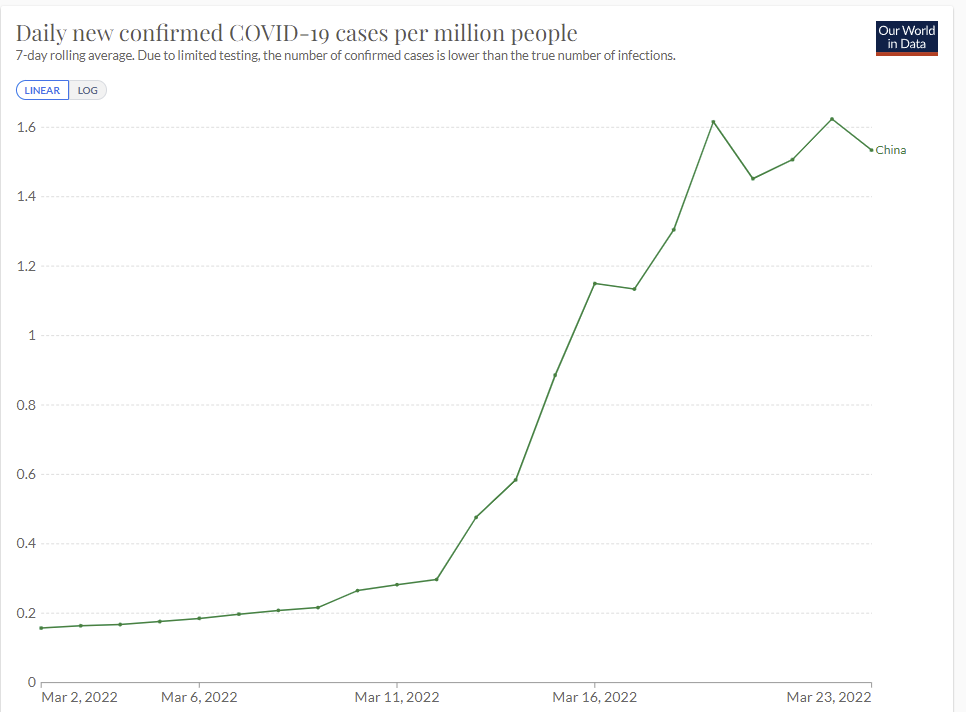
China ‘blames’ BA.2, continues to use half-measures.
Shenzhen is pretty much returning to normal, but many people were still getting tested every day so they could present valid negative results as needed for in-person business meetings, he said. “Let’s hope [with] all these experiences and all the China data, the Chinese government can find a way to go from zero-Covid to ‘live with Covid.’”
Shenyang locked down two days ago, population 9 million. But not Shanghai, despite its cases. Reuters reports.

A leading expert says it is contained. Well, that’s that. Except, how would that be true?
Here’s CNN:
China’s zero-Covid policy is showing signs of strain. But ditching it now could be a disaster
To respond, China has rolled out its well-worn methods for controlling the disease: placing tens of millions of residents under some form of lockdown, shuttering factories in the tech hub of Shenzhen, constructing makeshift hospitals to isolate cases in hard-hit Jilin province and rounding up “close contacts” of cases for surveillance or quarantine.
But this approach, known broadly as “zero-Covid,” is showing signs of strain.
…
“We haven’t prepared anything of what we need to prepare. How could we possibly dare to ‘lie down’ (and allow the virus to spread)?”
…
And even if this outbreak is brought under control, these questions will continue to rise to the fore in China, as containing Omicron amounts to a “Sisyphean effort” for China’s leaders and its people, he said.
“They are not going to eradicate all the Omicron cases in China…they are just waiting for the next round.”
This seems right. China has put its chips on Covid Zero and not used that time to prepare to lose gracefully, because that would cost face. Now that Omicron is both making it all but impossible not to lose and making losing potentially acceptable, they find they have not made the necessary prep work, and losing would perhaps not be so graceful.
Yet there remains all this talk of potential containment, despite talk like this.

The good news for China is that the graph above is not a rocket straight up, and the last four days look roughly stable. Even that is impressive if it is real, which I suspect it at least partially is not. They have done a better job stalling than I expected, but reach an equilibrium with this approach? I remain deeply skeptical.
Physical World Modeling
Moderna vaccine achieves its primary endpoint of similar-to-adult effectiveness in young kids.
Thread on BA.1 vs. BA.2, believes weight of Omicron’s advantage is primarily immune evasion and shorter generation time rather than having a higher baseline R0. Notes that BA.1 and BA.2 give strong cross-protection against each other.

This suggests a relatively small ~16% reproductive advantage over BA.1, while BA.1 continues to decline, implying R0 ~ 1.1 for BA.2 right now. That is of course still enough to create a huge impact on a weekly basis, but seems unlikely to be sufficient for a big surge or wave in the United States any time soon.
It is causing a wave of sorts in Europe, but as Kai says in this thread, it is not translating into health systems problems or lots of deaths. So the decision to open things up is still looking good.
A scary headline finding, if you don’t think about it at all.

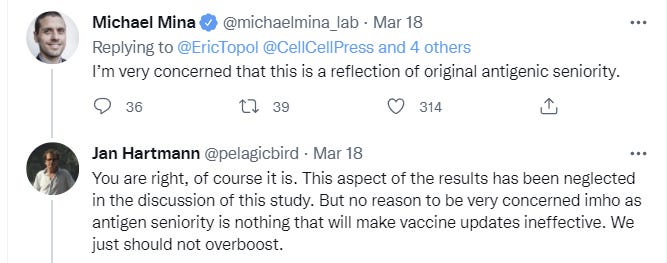
The flip side of this is oh look, those who get infected anyway don’t produce that many antibodies and they are still almost all fine. It always all depends on what you are controlling for. If we didn’t know that Omicron was milder despite this, this would be worrisome. As it is, the direction of the update is at best non-obvious.
South Korea has a huge infection rate, but relatively few deaths. Note that while delays can improve outcomes by allowing for more vaccination and better treatments, and as it turns out via Omicron, looks like the final case numbers are going to end up similar.
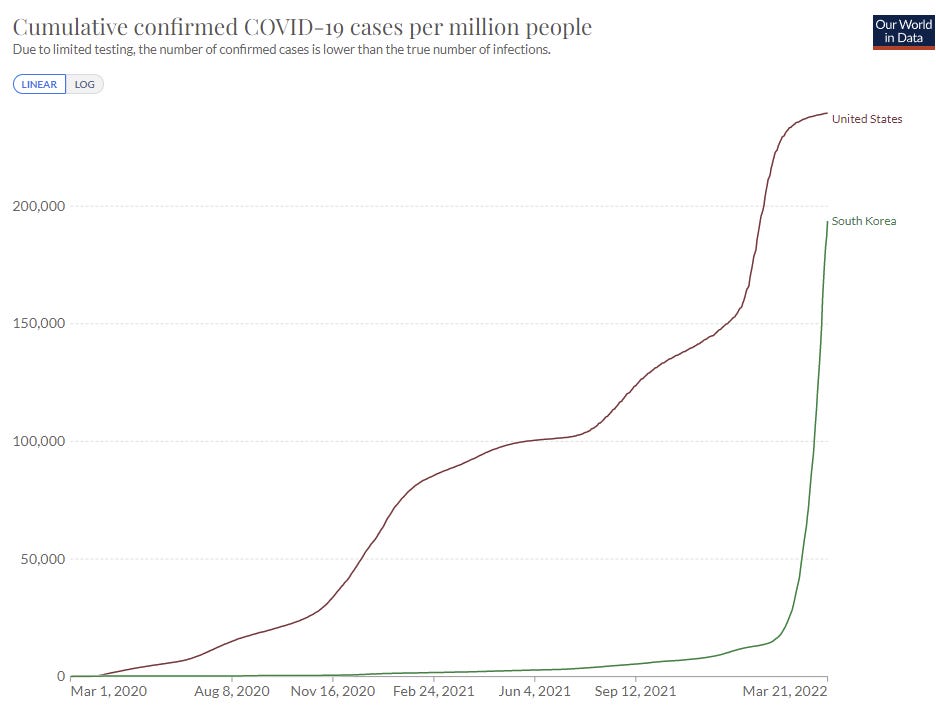
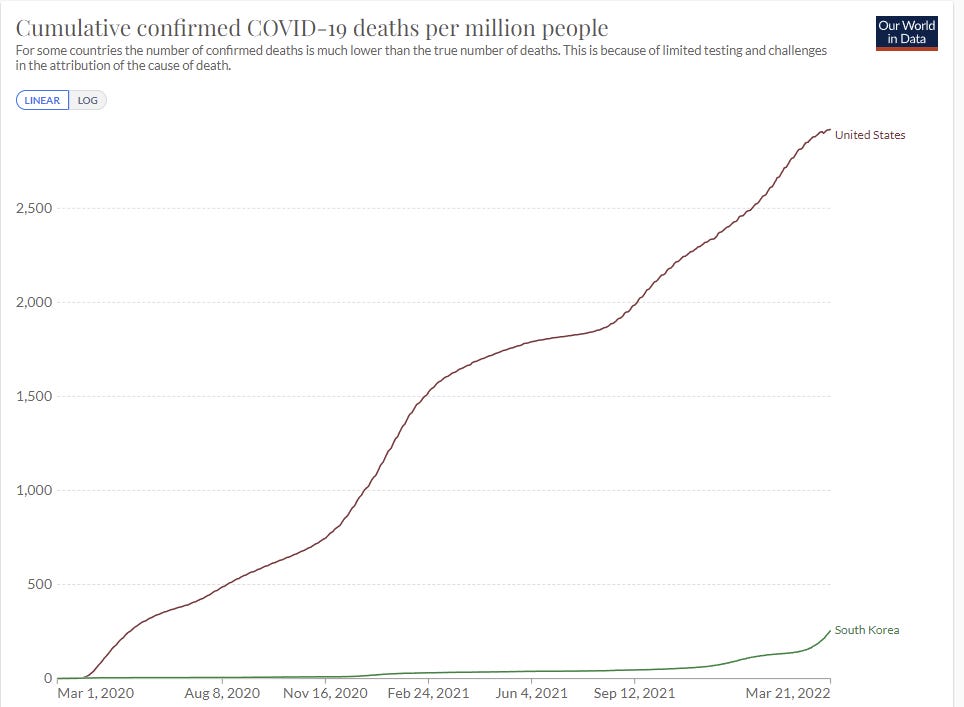
It is interesting the extent to which the USA cumulative death count looks like a straight line.
Most of South Korea’s cases lie within the three-week window – on this graph, about 2/3rds are less than three weeks old, so it is too soon to fully render a verdict here in terms of how much better the outcomes will be, but the fact that South Korea is not facing an overwhelming disaster at these case rates is victory enough.
Hong Kong’s death rate looks like it is going to be far worse (MR). There is very good reason to be worried about what happens when areas that have not previously had Covid are hard hit.
Report that young children were five times as likely to be hospitalized by Omicron as they were by Delta, conditional on a known infection. What was that?
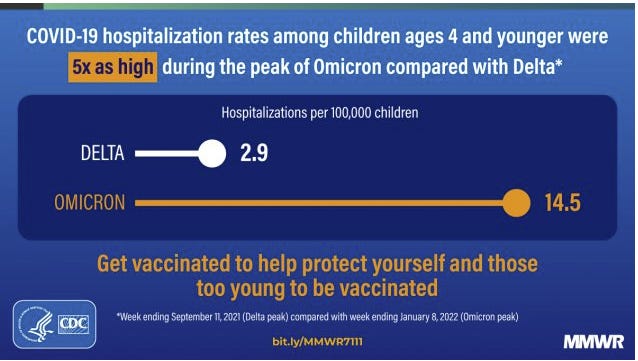
This is not per case. This is per population, for the weeks with the most cases for Delta and Omicron respectively. So mostly this is the fact that there were a ton of Omicron cases that week, being spun as if this result meant anything else or was remotely surprising.
Italian study claims that ventilation can cut cases in school by 82%. That seems too high to me, but it is still the lowest hanging fruit we have.
Federal Funding
We have still not yet received the Federal Funding. We cannot take our collages out to dinner, pay our brothers to come and sing, or (checks notes) buy vaccines for later in the year. Or, as far as I can tell, pay for the Covid-19 treatments for the uninsured.
Or for work to prevent other pandemics in the future, in addition to what is necessary to deal with the current one. Congress is unwilling to fund pretty much anything.
The verdict is in. The Covid-19 pandemic was insufficient to cause the United States to take pandemics seriously. We spent trillions, much of it on unnecessary and counterproductive overstimulation of the economy that is now causing lots of inflation. We don’t have billions to stop this from happening again, or even to provide for basic needs.
In an adversarial political system, such failures seem increasingly inevitable. One side spends all that it is given intending to come back for more, intentionally starving vital things of secured funds so that they can have a better case for more funding. The other side looks at that and says they’re not falling for such tactics, they’d rather not fund the vital things. And so it goes.
Prevention and Prevention Prevention Prevention

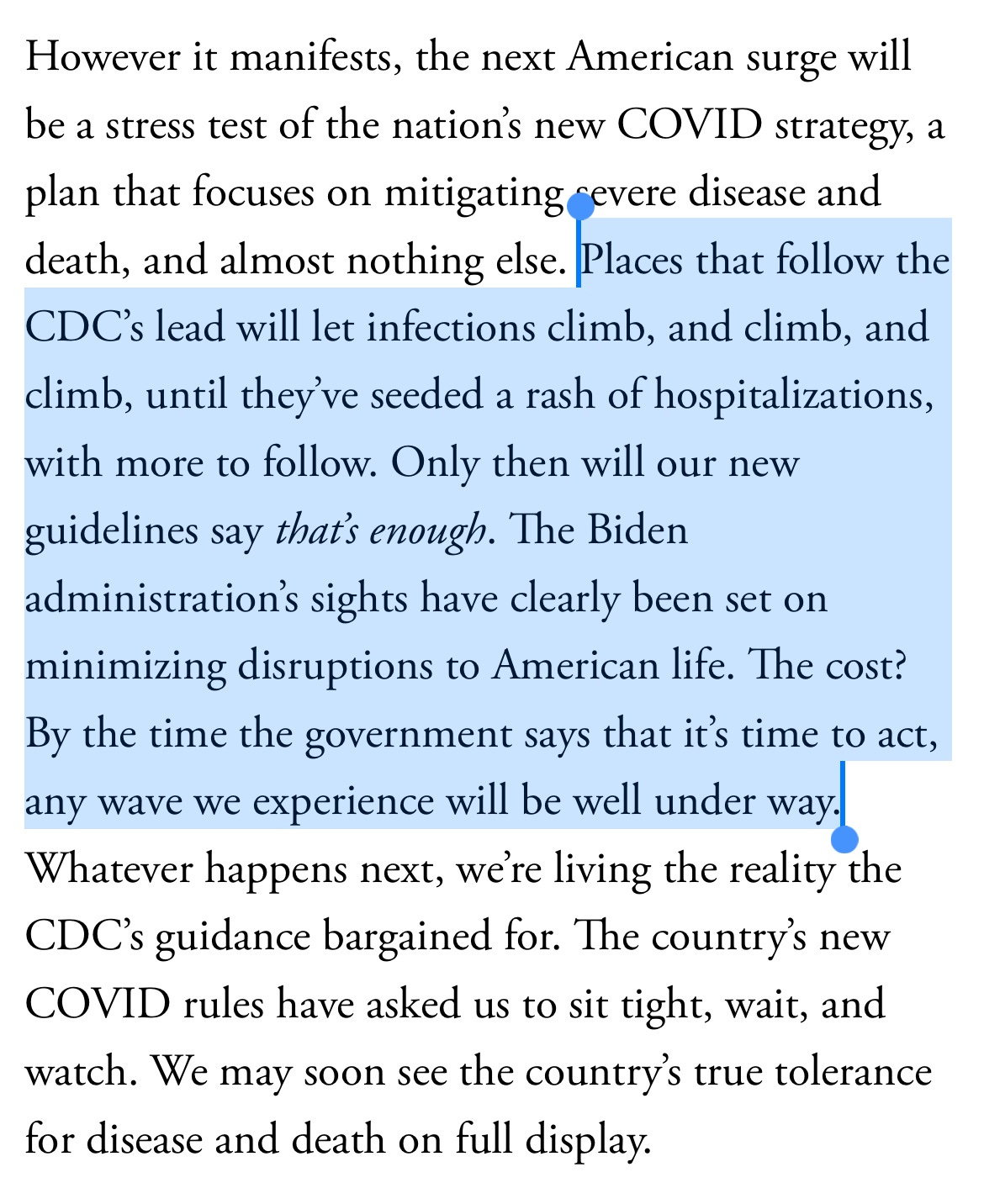
The alternate plan would be to impose extreme measures before there is ‘a rash of hospitalizations’? In other words, before there is a practical impact on people’s lives, and before you know if there even will be much of one? Before cases have grown common enough that the wave will cause itself to end rather than force us into Permanent Midnight trying to keep it at bay, except that will fail because when no one is getting sick no one is going to much care?
So, yes. Absolutely, this is the correct strategy. Good to have it explicit.
And to have the other position explicit.
In a sense, whether a bad BA.2 surge is nigh “doesn’t really matter,” he told me, “in terms of thinking about the things we should be doing now.”
In other words, a call to universally do all the things, forever, no matter what.
Airlines call for lifting of mask mandate.
A central question going forward continues to be whether ‘you might save a life’ is sufficient justification for ongoing prevention efforts. In which case, the question is ‘why is this cause different from all other causes?’
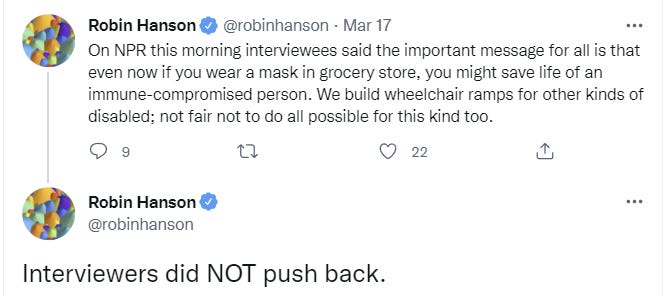

If such standards are used to determine behavior, civilization is impossible. As would be life itself.
Liberals continue to be very worried about Covid.



No need to mince words here. That 50% is mostly wrong.
What’s more interesting is, notice that this next chart is almost the same chart.

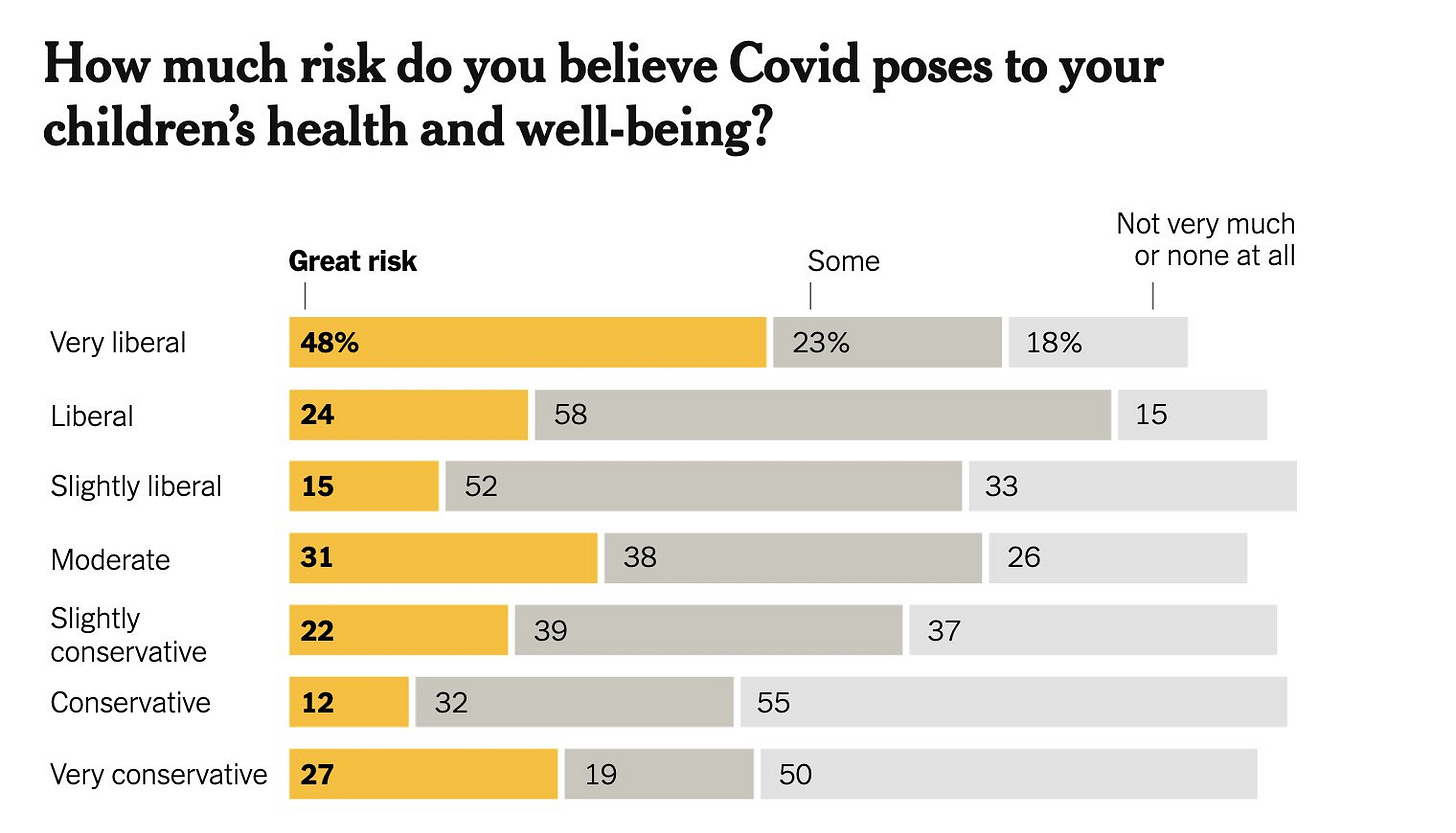
There is less than zero understanding that children are at less risk of Covid than adults, with five of seven groups being more worried about children, one being the same, and the only substantial drop being among the slightly liberal.
What’s most interesting here, to me, is that this is not the order one would expect. Slightly liberal people here are much less worried than ‘moderates’ or even the ‘very conservative.’ What’s up with that?
Especially considering this next one is much better ordered, although the wording of ‘will’ on the left and ‘should’ on the right is hopefully a typo cause it’s super weird?

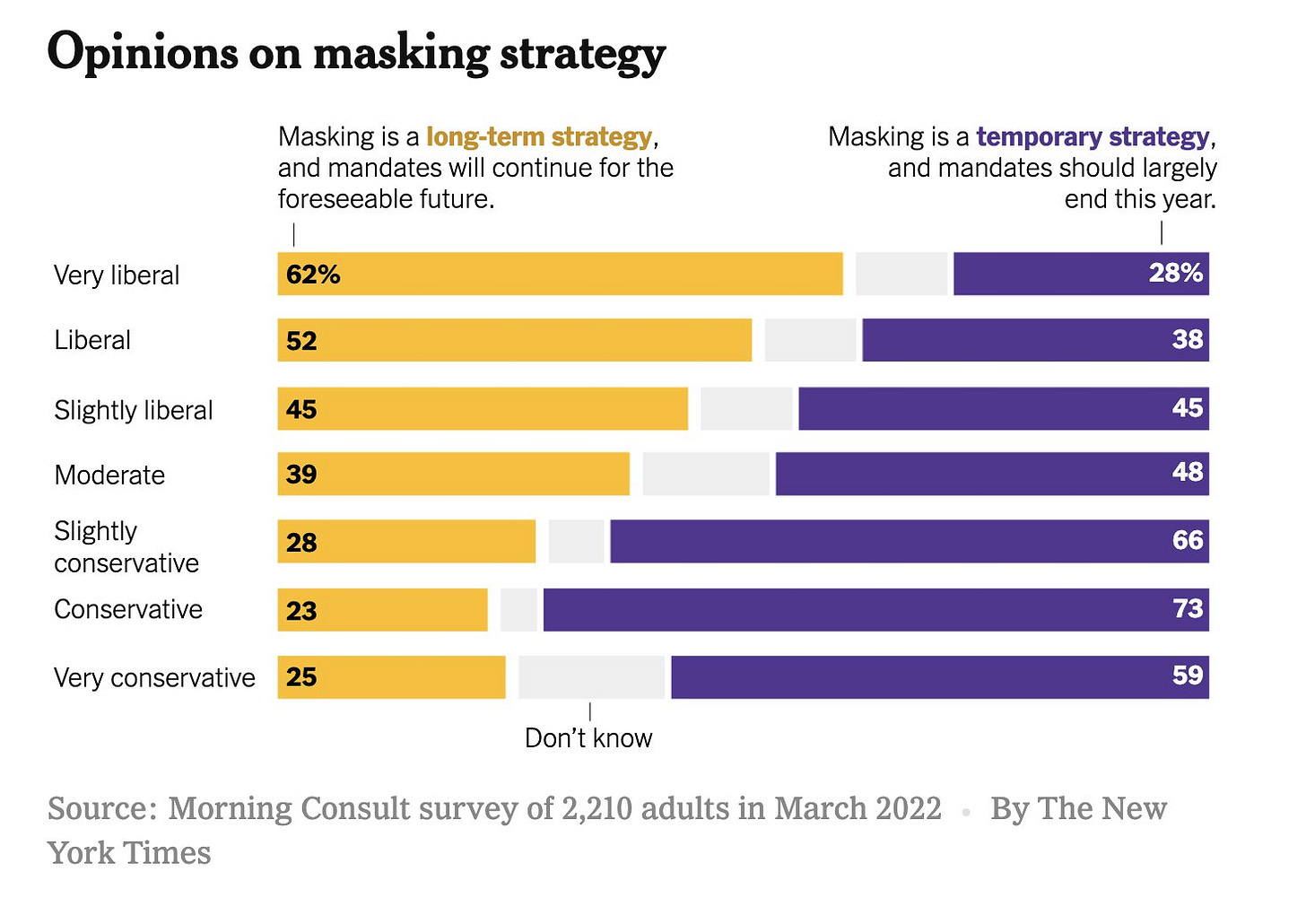
Very conservative people perhaps come by it somewhat more honestly, and are in fact ‘real’ conservatives, where a conservative person uses caution and worries about unknowns like new diseases, which could explain that bump. And for a similar theory, perhaps one could say that being ‘slightly liberal’ only happens for those capable of actually thinking in some sense, or else they’d be either more liberal (conforming to their group) or call themselves moderate. I’d like to buy that but it feels like a Just So Story, and the magnitude of this effect seems too big. Perhaps largely noise.
Meanwhile, many continue to be shut-ins, and 13 percent of people plan to make their changes permanent even if the pandemic fully goes away, while less than half plan a full return.
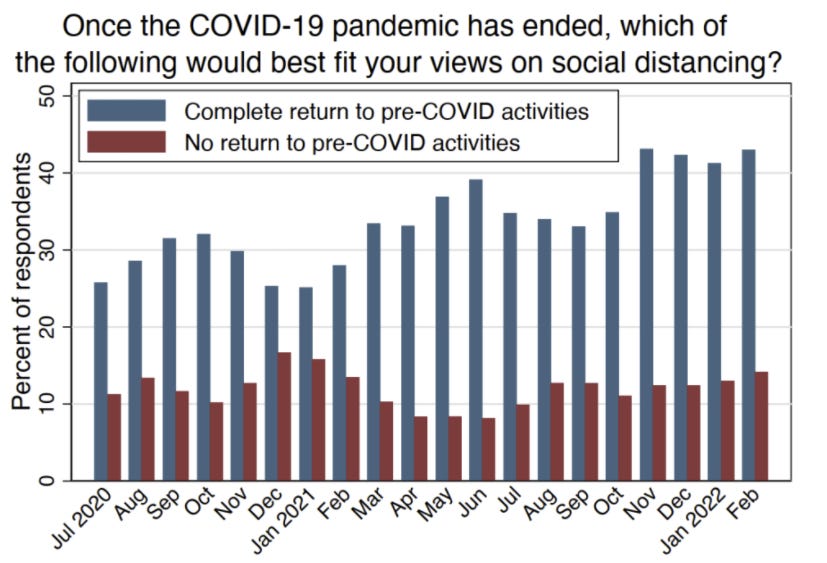
Long term, this alienation away from living life may inflict a far worse toll than anything else the pandemic did. We need to avoid this trap.
A good joke, and I get the point, but also seriously.

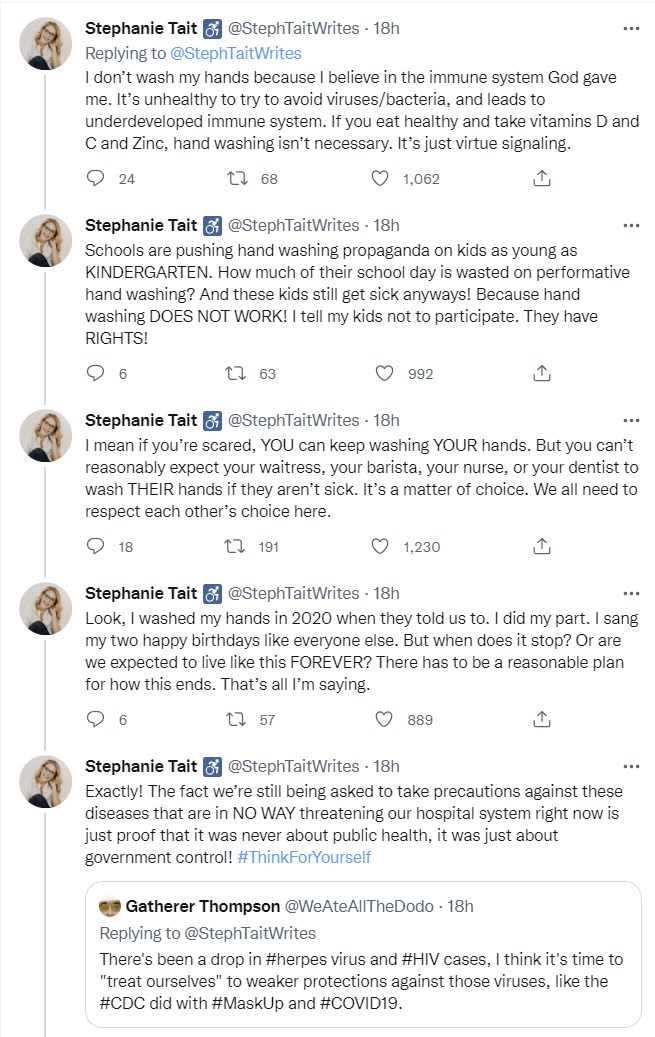
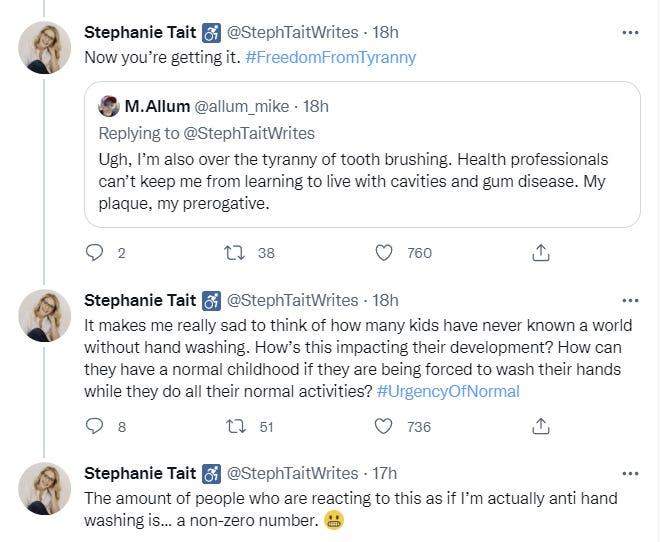
If you have not had the ‘pleasure’ of having a child who thinks words have meaning, who has had it drilled into him over and over how vital it is to wash his hands, and that then develops a rather unhealthy obsession with the need to wash them all the time in ways that are remarkably annoying and that damage his skin, then you are fortunate. If you did not have liquid glop forced upon you constantly in situations where it made no sense for two years, and having that be a stopper on activities as actively stressed people you care about scramble to find more glop, good for you. I was not so fortunate on either front, although situation has improved.
I certainly don’t want to be in a world where I lose points if I don’t wash my hands for no reason every time I do things like walk into a building. If you listened to the recommendations of ‘health professionals’ you would lose several minutes a day washing your hands, and often as a priority interrupt. Yes, you can afford any one such thing, but such things add up. One can always wash more often, or more carefully.
So yes, of course we should sometimes wash our hands, and doctors should wash theirs quite a lot, but we are talking price. And as with many other things, anyone who says they wash their hands less than the standard is going to get attacked for saying it and thus all such folks are inclined to shut up, and we should presume that talk about hand washing vastly overestimates actual handwashing rates.
As it turns out, what did hand washing do for us? A lot less than people thought, and the whole effort was almost certainly net negative because it outcompeted other prevention effects such as ventilation, being outdoors, masks and social distancing, all of which are vastly more impactful.
Biden administration releases new guidance on ventilation standards for schools and businesses. Ventilation is one of those things that is a good idea anyway, so a good place to look for worthwhile things to be doing. The guidance is two pages long, which seems like an ideal length, and it is recommendations rather than requirements. I do still worry about additional feature creep that renders it increasingly slow and expensive to operate in ordinary life, since this involves things like ‘hiring experts’ and such ‘recommendations’ send to turn into requirements (e.g. those praising this as a strong ‘first step’). As an only step, though, it seems good, and if we are going to impose requirements and be coercive this is a relatively good way.
We have to be willing to consider such clean examples.
Protesters at New York City restaurants that continue to require proof of vaccination, which they are entitled to do if they so choose. It is hard for me to get into the mindset where any of this is a good use of someone’s time – either the checking of vaccination cards, or the protesting that someone is checking them. If a place was continuing to check vaccine cards, I’d shrug and show them, but it would be a mark against me going back because I dislike annoying things.
Meanwhile, rates versus levels.

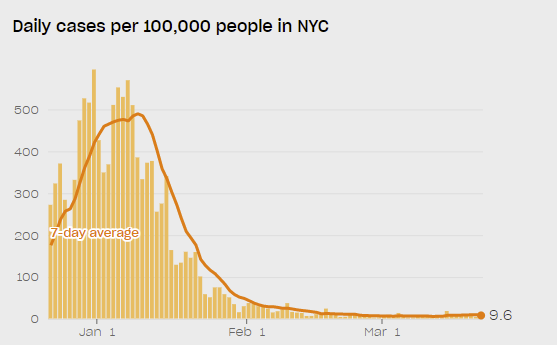
We need to ‘pick up the pace’ proportionally to cases. I walk by the kiosks on the sidewalk offering free Covid testing. There is almost no one ever there. Many providing the service no longer bother masking. Doing extra tests now, in advance of the cases, does not accomplish anything.
Think of the Children
New York City to lift the somehow still existing mask requirement for 2-4 year olds.
Source is biased but also this matches my personal experience quite a lot.

In Other News
I mean, yeah, sure, CDC Delenda Est and all that, and yes the fact that their documents still say that vaccine immunity is superior to natural immunity is a “myth” is rather embarrassing and rather central, and yes the CDC has done tons of rather awful science in the pandemic, but I still don’t think that finding one blatant error in a document should be sufficient here. There are lots of documents. With lots of errors, mind, and overall terrible performance, but one does need to show the pattern.
Overview of the prospects for another Operation Warp Speed based on what we did and why it worked (MR). I am more optimistic than this on what results we would get given an actual attempt, even if not all the positive conditions are present.
The Precautionary Principle is not a dumb idea. A cost-benefit analysis that only includes the known risks is going to undervalue unknown risks, so if those unknown risks clearly favor one side or the other it is necessary to give some weight to that. The underlying post here is centrally an attack on Emily Oster for daring to consider things like cost-benefit or quality of evidence at all, using arguments like ‘some right-wing thinkers and some corporations like her arguments’ and ‘her arguments are used to justify policies I do not like’ and even ‘her audience is white.’ This Twitter take on the hit piece is somewhat less generous than that.
Nate Silver’s point here I think is mostly correct, at this point, if anything understated.

We don’t have ‘adequate substitutes’ for in-person interactions or being without masks. What we have are less inadequate substitutes, that let us muddle through. Emily’s recommendations on what pregnant women can safely do are similar. Either we are using the precautionary principle on all risks, or it is simply an excuse to do whatever ‘public health experts’ are worried about this week, forever.
At this point, there are large risks to sustaining interventions, and there are no studies to show that these risks are not worth worrying about and good reasons to expect the effect sizes might be very very large. So the ‘precautionary principle’ does not point in an obvious direction.
However, I do want to notice that yes, we have made a lot of pandemic arguments entirely about individual risk in many contexts where a lot of what matters is collective risk. We scream about the public health need to vaccinate, then argue that each individual person should make the choice purely selfishly, then when they don’t make the ‘right’ selfish decision we do various other things, and so on. Either make the real case, or don’t.
Press Secretary Psaki says “we don’t know” (26 second video) that Biden faces more danger from Covid than a person in their twenties. One could in theory steelman this reaction by saying that “we don’t know” that any particular old person will have a worse outcomes than any particular young person, and that would be the best kind of correct (aka technically correct), but given the spirit of the question, not so much.
Psaki now has Covid for the second time. I have the feeling she is properly not so worried about this, rather than saying ‘we don’t know.’
Kai Kupferschmidt has decided that the study of ‘misinformation’ is vital to work as a public health reporter, and has written an article about that. Extreme dangers are cited, evolutionary explanations are given, extreme solutions are proposed, such as:
Bak-Coleman, who has studied how schools of fish suppress false alarms from fish in the periphery of the swarm, believes the density of connections on social media make it harder to filter out bad information. Bergstrom agrees. “If we actually cared about resisting disinformation, Twitter and Facebook might be better off if they said, ‘Look, you can have 300 friends and that’s it,’” he says.
The solution to stopping the spread of misinformation is to stop having so many friends, or even more simply, stop conveying so much information.
The mistake, the ‘misinformation’ inherent in the situation, is the idea that there is a magisterium called ‘misinformation’ rather than one called ‘information.’ When we ask things like:
But that, too, needs study, he says, as do strategic questions: “What would agents do if they wanted to try to inject misinformation into a network? Where would they want to be? And then the flip side: How do you try to counter that?”
We are asking good questions, but what we are mostly asking is about the spread of information at all. Whether something happens to be true is certainly one input, but if you want a system to filter for true information that requires people build models and think. If you want it to filter for popular or official information, that is different, and then limiting what unpopular or unofficial people can say starts to look attractive. That kind of thinking seems unlikely to end well.
Thus, this kind of theory.
A recent review in Nature, however, argued that people do not fall for misinformation because of polarization. The authors cited studies suggesting true information is more likely to be believed than false information, even if it doesn’t align with one’s political views. “Politics does not trump truth,” they concluded. The real problem is people sharing information with little attention to whether it is true, the authors wrote.
So that comes back to the question of ‘what is misinformation?’ If misinformation is ‘information that is not true’ then the solution is to have more people do more model building and truth seeking. If misinformation is ‘information officials disagree with’ then you want the opposite of that, but you want to combine it with rebuilding official credibility in the eyes of the public. Which is useful in any case.
Solutions like ‘prevent people from communicating’ should be expected to reliably backfire barring extreme measures that would make us cease to be a free society. Russia can pull off this trick, but I hope we will not use that level of force.
I am deeply confused what point this article about Covid testing is trying to make, other than generally complaining that tests sucked so someone should get blamed for it? There are claims of non-standardization, of both undercounting and overcounting, and a general vibe of ‘sometimes the tests were wrong so everything is terrible.’ The main result of such things if any is likely more rules about tests that make tests less practically useful. The headline claim is of overcounts in the number of cases, as if that meant we were treating Covid as more of a problem than it was, or that it could possibly make up for the undercount of people not tested. What of course is being missed there is that an overcount would be bad news, since it would mean the death rate was higher.
Not Covid
Would this make the world better or worse? Poll respondents mostly say worse. I say better.